![]() 1st Battalion 22nd Infantry
1st Battalion 22nd Infantry ![]()
22nd Infantry Regiment on the Mexican Border
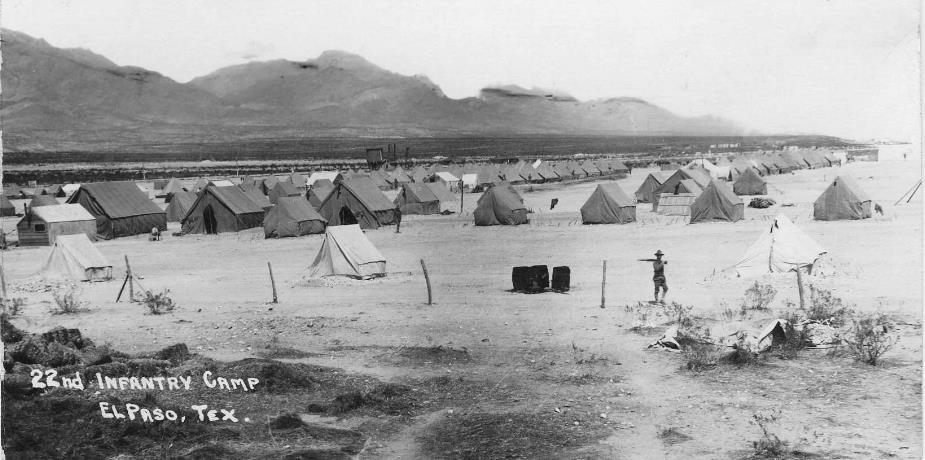
Postcard showing the 22nd
Infantry Camp, El Paso, TX.
Postcard has a 1912, Ft. Bliss postmark.
webmaster's collection
In response to the turmoil of the Mexican
Revolution, Regular US Army troops were concentrated along the
Mexican border in the spring of 1911,
ostensibly for maneuvers and to aid civil authorities in
enforcing the neutrality laws. In fact, this mobilization
constituted a show of military strength
and a testing ground for new tactical organization. US
troops were organized into a brigade at Galveston, TX, and a
partial brigade at San Diego, CA.
The 22nd Infantry was sent to Fort Sam Houston,
Texas in 1910. Though the 22nd Infantry did not
join the punitive expeditions of 1914 and 1916,
which crossed into Mexico, the Regiment remained at various posts
along the Mexican Border for seven years.
In April of 1917 it was moved to Fort Jay, New York, in
anticipation of the US entry into the World War.
The first U.S. Army Division of the twentieth
century was conceived not necessarily with combat power in mind,
but primarily as an administrative formation used to aid
mobilization. Its roots lie in an effort to improve training
procedures and the speed of assembly.
America’s experience in its war with Spain in 1898 spurred a
rethinking among the Army’s bolder leaders of its
organization for fighting.
Secretary of War Henry Stimson and Army Chief of Staff General
Leonard Wood also wished to eliminate the many small posts
inherited from the constabulary and Indian fighting days and
reorganize the Army into larger garrisons. At the very least,
Wood and Stimson believed
that they should form temporary troop concentrations on paper
that would aid mobilization purposes.
At San Antonio, TX, where the main concentration occurred, units
were organized into the U.S. Army's first modern tactical
division, that is,
one containing the combined arms of infantry, cavalry, and
artillery. The so - called “Maneuver Division” was
formed at San Antonio, Texas, in March 1911.
This grouping gave officers experience handling large bodies of
men and permitted testing and experimentation with new Signal
Corps equipment,
such as telegraph and wireless telegraph sets (radios) and
airplanes. The Division conducted extensive field exercises
(including the use of airplanes and radio)
in an attempt to improve the US Army’s low efficiency
reports. The shortcomings of the resulting undermanned and
unprepared Maneuver Division
later gave Army leaders the ammunition to call for an improved
organization of the Army as a whole.
Stimson subsequently called on the U.S. Army War College to plan
for the tactical reorganization of the Army into a permanent,
Division-based organization.
In early 1913, Stimson persuaded the Army’s general officers
of the merits of the divisional plan, and the reorganization of
the Army into four divisions
soon followed. These divisions consisted of three infantry
brigades, a cavalry regiment, an engineer battalion, a signal
company, and four field hospitals.
The wisdom of the new plan soon became evident as the Mexican
Revolution threatened to spill over the Rio Grande. What once
required scores of orders
now required only one, and with that the 2nd Division commanded
by Brigadier General Frederick Funston at Texas City and
Galveston was mobilized.
During its brief existence, Mar
12- Aug 7, 1911, the Maneuver Division, commanded by MG William
H. Carter, conducted no maneuvers
and never reached full strength before its disbandment.
The experience gained, nonetheless, was put to use in Feb 1913,
when the 2d Division was mobilized at Texas City and Galveston,
TX, again under the command of Carter.
The 22nd Infantry Regiment was moved from Fort
Bliss to Galveston, to become part of the 2nd Division.
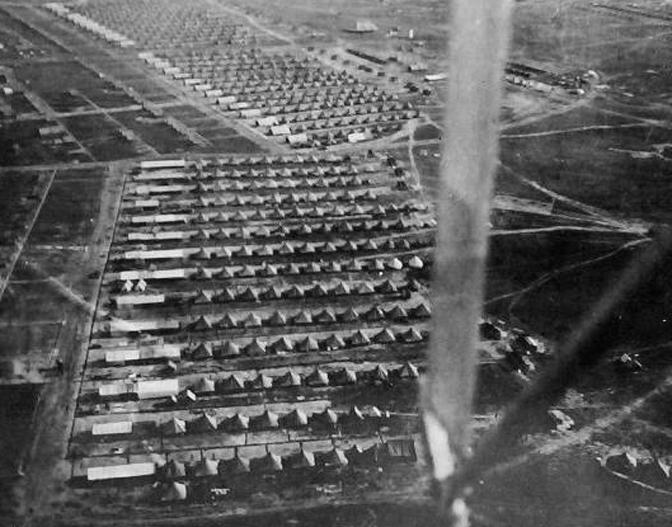
1913 aerial photograph- taken from the open
cockpit of a plane of the 1st Aeroplane Squadron, on its very
first Military Deployment.
Part of the DH-4 Jenny aircraft from which the photo was taken
can be seen in the picture.
In 1913, the US Army deployed the entire 2nd Division to Texas
City, Texas, in anticipation of problems on the US / Mexico
Border.
This included 14,000 troops, 3,000 animals, and for the first
time, the 1st Aero Squadron was deployed with them.
Shortly after the encampment was set up, this photo was taken of
the encampment.
In the foreground are the tents and buildings of the 22nd
Infantry,
immediately above that is the 11th Infantry,
and above that is the 18th Infantry.
The Texas City Encampment was completely leveled by a massive
Hurricane in August 1915,
and was moved to San Antonio, and to locations along the Rio
Grande.
|
Souvenir of the 22nd
Infantry's service Brass fob meant to hang from a
watch chain At the top is 22 ND INF. At the bottom inside a
five-pointed star webmaster's collection |
**********************
The following narrative
describes the duty of the 22nd Infantry 1911-1915
and is taken from a history of the Regiment compiled under the
direction of
CPT G. C. Graham, Regimental Adjutant 1922
March 13, 1911, orders were
received directing the formation of a complete Infantry Division
and a Cavalry Brigade at San Antonio, Texas.
These were designated, respectively, the Maneuver Division and
the Independent Cavalry Brigade.
Major General William H. Carter, U. S. A., was placed in command
of these units.
The 22nd Infantry was assigned to the Second Brigade of the
Maneuver Division.
The formation of the division
was completed between March 10 and 16, 1911, but the 22nd
Infantry remained in garrison until April 11,
absorbing a large contingent of recruits during February and
March. On April 11, Regimental Headquarters less the band,
and the First and Second Battalions, left their quarters at Fort
Sam Houston and proceeded to camp at the division mobilization
point.
Here they were joined on April 14 by the Machine Gun Platoon of
the regiment.
April 25, the Second Brigade left camp for Leon Springs, arriving
at noon the following day.
The brigade remained at Leon Springs until the 29th, when it
returned to the division camp at Fort Sam Houston.
In the meantime the regiments were receiving recruits in such
large numbers that the authorized strength was exceeded,
and the War Department finally issued instructions allowing an
enlisted strength of one thousand men for each of the Infantry
regiments
of the Maneuver Division. At first this resulted in a shortage of
the necessary equipment for the men, but sufficient supplies of
all kinds
were on hand in the division in the course of a few days. A
review of the Maneuver Division was held in camp on April 1,
and on the 16th the entire division paraded in the city of San
Antonio. May 13 the division again marched to Leon Springs for
maneuvers,
remaining there until May 21, when the troops returned to
camp. June 2, the division again marched to Leon Springs
to conduct further division maneuvers. The return march to Fort
Sam Houston was made during the night of June 8-9,
the division covering 26 miles during this time. The following
day the 22nd Infantry went back to their permanent quarters at
Fort Sam Houston.
The following is a photo post card sent
by a Soldier in Company A of the 22nd Infantry,
showing members of Company A having chow at their yet to be
completed dining facility at Fort Sam Houston:
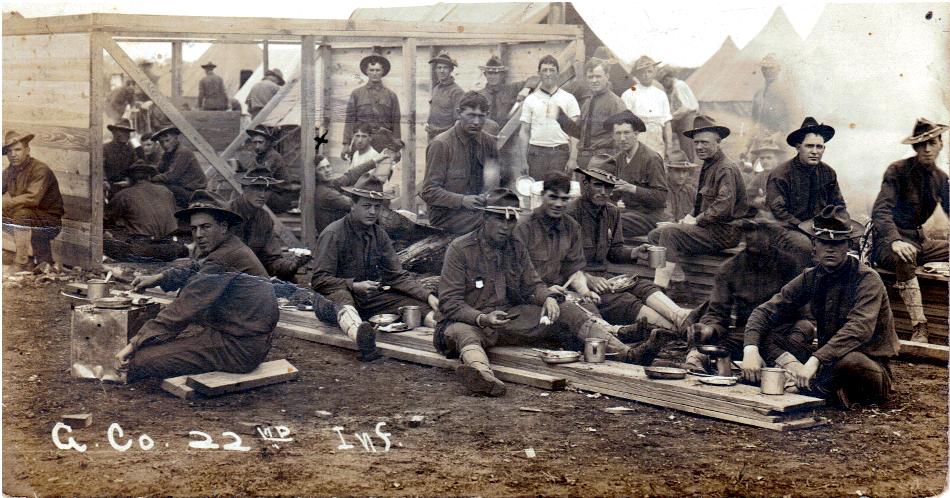
The Soldier seated on the planks,
center of photo, appears to be wearing a souvenir badge of the
type described in the above text
on his right breast pocket. Two Corporals can be seen, seated
back to back on the stack of planks in the right of the picture.
All uniforms and equipment are of the older patterns, the model
1910 uniforms and equipment not yet having been issued to them.
Note the light blue hat cords of the Infantry branch. The photo
was taken at the camp being built for the mobilization
of the Maneuver Division at Fort Sam Houston in 1911.
The sender of the postcard is
"Bert", and he is the soldier sitting against the post
holding his leg up. There is a black "x"
marked above his head.
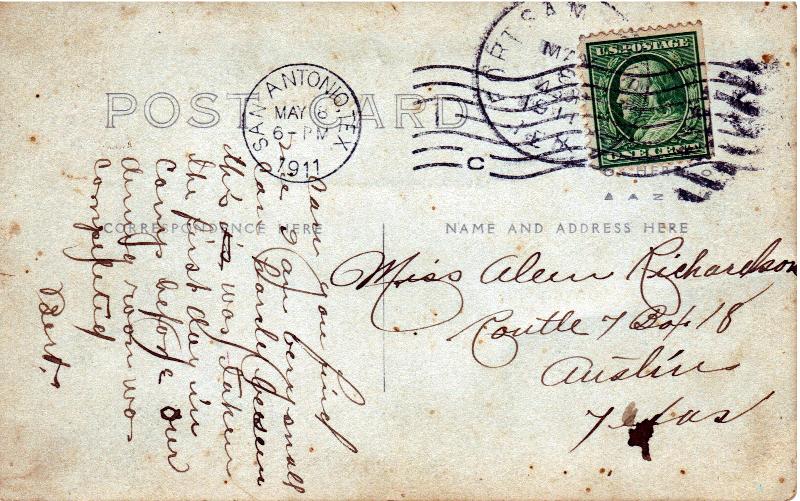
The address side of the post card,
showing the May 8, 1911 postmarks of both the mail room at Fort
Sam Houston,
and of the post office in San Antonio. The inscription reads:
" Can you find
me I am very small
Can hardly be seen
this was taken
the first day in
camp before our
dining room was
completed
Bert . "
The above post card is courtesy of Michael
Smith, and is addressed to his grandmother's sister Aliene.
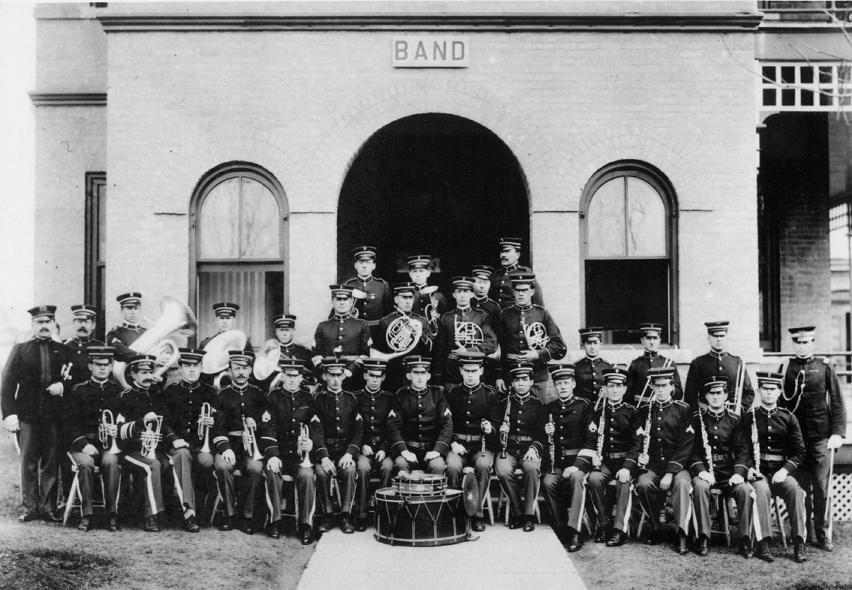
22nd Infantry Regiment Band, Building
646, Fort Sam Houston Texas 1911
photo from Vintage
Brass Band Pictures website
A Maneuver Division of
about 12,000 troops was assembled at Fort Sam starting March 7,
1911, while two backup brigades went to Galveston and San Diego,
Texas. At Fort Sam and the military reservation at Leon Springs,
troops tested the Army's new Field Service Regulations and tried
out newfangled technology, such as aircraft and "wireless
telegraphs."
Joined in April by members of the Texas National Guard, the
troops of the "Great Military Maneuvers" and their
visitors were courted by San Antonio retailers in advertisements,
welcomed by local businesses awarded supply contracts and
lionized by civilians.
"The glamour of the brass button and the uniform has a
peculiar charm," says the San Antonio Express, April 19,
1911. "In San Antonio, hundreds are for the first time
witnessing something of real soldier life." An estimated
100,000 citizens lined the sidewalks "massed five or six
deep" or "hung out the windows and balconies" to
watch the Military Parade, "feature event of the second day
of the spring festival."
Newspaper accounts differ, but troops numbering 6,000 to 8,000
took to the downtown streets April 18, 1911, in "the
greatest military parade since the Army was reviewed after the
close of the Civil War."
Led by the 22nd Infantry, with the Signal Corps last in line, the
parade represented "the flower of the American Army,"
including artillery and cavalry as well as infantrymen marching
in columns of four.
It was a long line. Troops formed at 1:30 p.m. in the Fort Sam
maneuver camp and followed a circuitous, six-mile route to pass
"cheering throngs" and a reviewing stand on Alamo
Plaza. To "the steady rhythm of thousands of marching
feet," they made their way along Grayson Street to Avenue D,
to the first pass in review at 3 p.m. From Alamo Plaza, they
turned west on Commerce Street toward Main Plaza, which they
circled on their way to Flores Street and a circle of Military
Plaza, back to Commerce to San Saba Street, then on to Houston,
Navarro and Travis streets, then to Avenue C and homeward on
Grayson. It took an estimated hour and four minutes for every
outfit to pass the brass on the reviewing stand, but the
"parade was over, and the men back in camp by 5:30
p.m.," says the Express.
San Antonio Express-News
Robin M. Ellis, vice president,
Fort Sam Houston Historical Association
http://www.mysanantonio.com
The regiment was relieved from duty with the
Maneuver Division on July 22, and immediately ordered to Austin,
Texas,
to arrive at that place on August 6, to take part in the field
training of the Texas National Guard.
Other troops ordered to the same duty included one troop of the
3rd Cavalry and one battery of the 3rd Field Artillery.
The regiment left San Antonio at 5:30 p. M. July 31, 1911, and
was joined by the cavalry and field artillery troops the
following day.
The average daily march of the command from San Antonio to Austin
was 16 miles, and the latter place was reached on August 6
according to schedule. The regular troops went into camp at Camp
Mabry, where they remained until August 17.
On that day the return march was commenced, and the column
reached San Antonio on the 21st.
During the year many men were lost to the
regiment by discharge; between January 1 and March 31
fifty per cent of the enlisted men were discharged, and of these,
thirty per cent, re-enlisted in the regiment.
November 10, 1911, Colonel Alfred Reynolds relinquished command
of the regiment, and took advantage of a well-earned leave of
absence
lasting until March 1, 1912, when he was placed on the retired
list of the Army.
Colonel Reynolds joined the 22nd Infantry on April 10, 1906, at
Fort McDowell, California,
and remained in active command of the regiment until the date of
his departure.
Colonel D. A. Frederick was attached to the
regiment on October 15, 1911, and assumed command on the
departure of Colonel Reynolds.
The former had previously served with the 22nd as a Major from
January 26, 1906, to October 28, 1908.
The year 1911 brought about many other changes among both the
commissioned and enlisted personnel of the regiment.
The following year was taken up for the most
part with more or less routine duty along the Rio Grande,
and in recording the history of the various units of the regiment
during this period only the changes of station and the basic
duties are set down here.
These facts are taken almost verbatim from the monthly returns of
the 22nd Infantry for 1912.
The month of January was spent in garrison at Fort Sam Houston.
February 24, the entire regiment was ordered to El Paso, Texas,
for guard duty along the Mexican border.
The regimental transportation and animals left Fort Sam Houston
on the morning of February 25;
the first section of troops at 12:05 P. M. the same day, the
second section following three hours later.
The regiment, as a unit, went into camp at Fort Bliss February
27; distance traveled from San Antonio, 630 miles.
March 1, the First Battalion, 22nd Infantry, relieved the 18th Infantry along the Rio Grande; units of the regiment taking station as follows:
Battalion Headquarters and Company B, Santa Fe
Bridge ;
Company A, Stanton Street Bridge;
Company D, near Washington Park;
Company C, Smelter.
Small detachments were sent also to Pecos River High Bridge;
Columbus, New Mexico;
Canutillo, New Mexico; Pelea, New Mexico; Clint, Texas, and
Fabens, Texas.
The Second Battalion was assigned to duty at
various points along the Rio Grande, with instructions to enforce
the neutrality laws along the border.
This battalion was relieved by the Third on April 2, and the
Third Battalion, in turn, by the First on May 2.
June 3, the Second Battalion, 22nd Infantry, less Company G,
relieved the First Battalion, 18th Infantry, less Company A.
Company G, 22nd Infantry, was sent to Yselta, Texas, to replace a
troop of the 14th Cavalry.
At the same time the Third Battalion, less Company K, relieved
the First Battalion, less Company D,
the relief of the latter company by the former taking place on
June 16.
June 28, Company K was replaced by a troop of the 3rd Cavalry,
and another troop of the same regiment
took the place of the 22nd Infantry detachment at Columbus, New
Mexico, June 27.
This detachment proceeded from Columbus, New Mexico, June 27.
This detachment proceeded from Columbus
to Huachita and Hernandez, New Mexico. In the meantime the First
Battalion had been in camp at Fort Bliss, Texas, since June 3,
where the troops engaged in the usual camp duties.
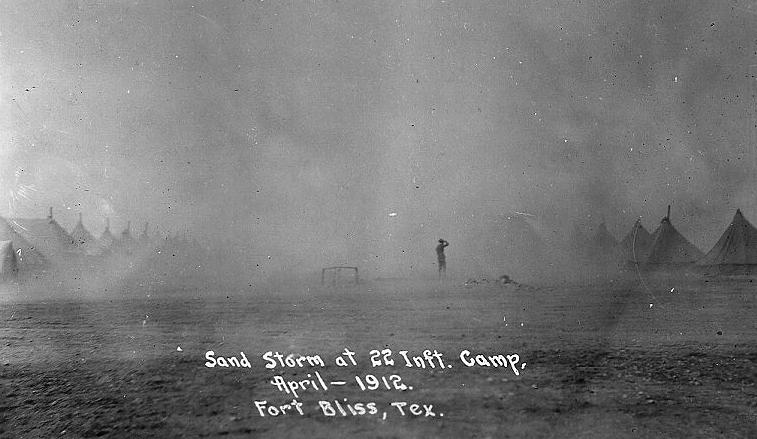
July 2, the second battalion, 22nd Infantry,
turned its stations and duties over to three companies of the
18th Infantry and Company D of the 22nd.
On the same day the Third Battalion, less Company K, was replaced
by the First Battalion. These two battalions again changed places
on August 2, when, also, the Second Battalion, relieved a like
unit of the 18th Infantry.
August 9, Company B was transferred by rail to Fort Hancock,
Texas, in compliance with orders
issued from the headquarters of the patrol district of El Paso.
September 2, the Second and Third Battalions were relieved from
duty along the river and returned to camp at Fort Bliss.
Companies A, C and D proceeding from Fort Bliss to posts on the
Rio Grande.
September 20-21, Company B, which had been on duty at Fort
Hancock since August 9, marched back to Fort Bliss.
Distance marched, 33 miles.
No changes of station occurred during the following month of
October, and all organizations of the regiment
continued their guard and patrol duties along the border. Annual
target practice was completed by the Second Battalion October 23,
and the Third Battalion proceeded to the range two days later.
November 2, the Second Battalion relieved a battalion of the 18th
Infantry along the border; battalion headquarters, with Companies
E and F,
took station at Washington Park; Company C at Ysleta; Company H
at the El Paso foundry.
On the 16th, the Third Battalion, less Company K, replaced the
First Battalion, less Companies A and B.
Battalion headquarters and Company M were posted at the Santa Fe
bridge; Company I at the cement works; Company L, at Harts Mills.
The following day, Company G was relieved from its post at Ysleta
by a troop of cavalry,
and then in turn replaced Company A at the Stanton Street bridge,
the latter organization returning to Fort Bliss.
The Third Battalion completed target practice November 14, and
was immediately followed on the range by the First Battalion.
No further changes of station or duties took place during 1912 or in the first month of 1913.
On the evening of February 24, orders were
received directing the movement of the 22nd Infantry to Texas
City.
The regiment broke camp on the 25th and spent that day loading
the heavy baggage on the train,
this work being accomplished during a violent wind and rainstorm.
The regiment reached Texas City on the 28th and went into
temporary camp
along the railroad track. The distance traveled by rail in making
this journey amounted to 870 miles.
The months of March and April were taken up with field training
and exercise at the Texas City maneuver camp.
As a part of this duty the 22nd Infantry marched to Galveston,
Texas, on May 12, pitched shelter tents and remained until the
19th,
when they returned to Texas City by marching; the distance
marched was 35 miles. Field training continued during the rest of
the month.
June 24, the regiment marched to Dickinson, Texas, pitched
shelter tents, remained in camp two days, and returned to Texas
City on the 26th,
working out a maneuver problem on the march. The distance marched
was 24 miles.
August 11, the 22nd marched to Galveston, Texas, and went into
camp a short distance north of the Crockett reservation.
During the remaining four months of 1913 the regiment remained at
Texas City, where it was occupied with the routine duties of the
camp.

The 22nd Infantry Regiment camp at Texas City, Texas
Library of Congress photo 02675u
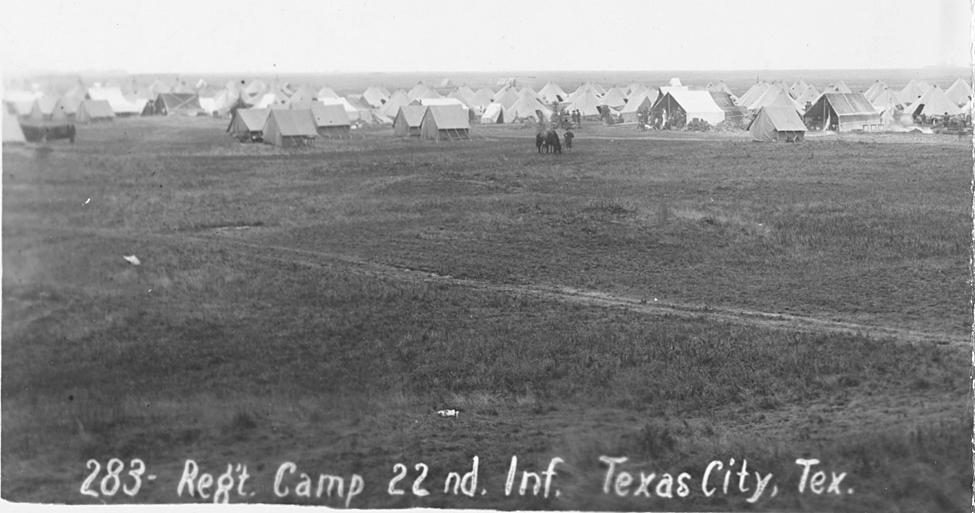
Enlargement of photo of 22nd Infantry Regiment camp at Texas City, Texas (left side)
Library of Congress photo 02675u
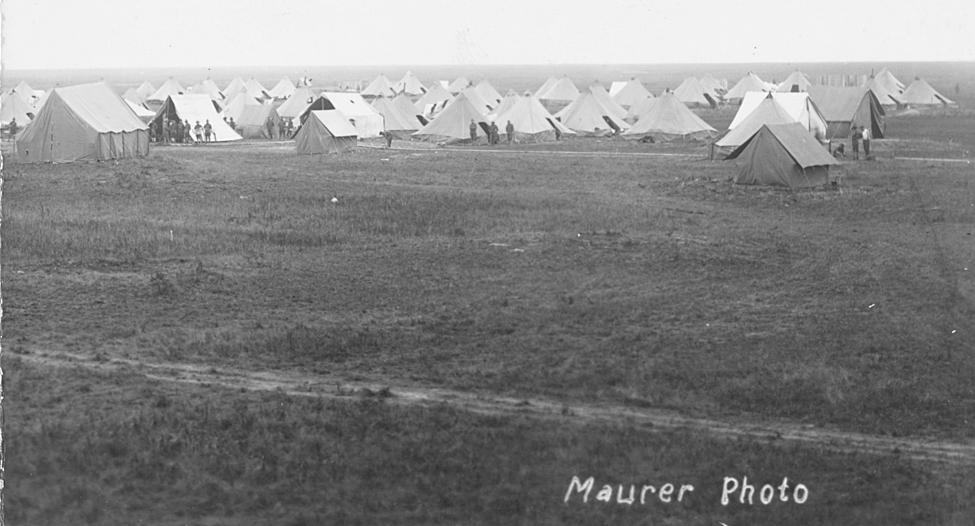
Enlargement of photo of 22nd Infantry Regiment camp at Texas City, Texas (right side)
Library of Congress photo 02675u
Field exercises and maneuvers continued during
the early part of 1914; in January the entire regiment took part
in a thorough course of field firing.
In March two divisional maneuvers took place, the 22nd Infantry
participating in both.
April 16, 1914, the regiment, as a unit of the Second Division,
started on a march to Houston, Texas,
for the purpose of taking part in a parade in that city on San
Jacinto day, April 21. They reached Houston on the 19th, but at
3:25 A. M., April 20,
the regiment was ordered to march at once to Texas City. The 22nd
Infantry, as part of the Sixth Brigade,
left Houston at eight o'clock on the morning of the 20th, and
reached Texas City on the 22nd.
At Texas City the regiment again went into camp, and took up its
former duties.
April 18, Company C, under Captain John B. Sanford, proceeded on
the harbor boat Poe, to Galveston,
to engage in a military exhibition at that place.
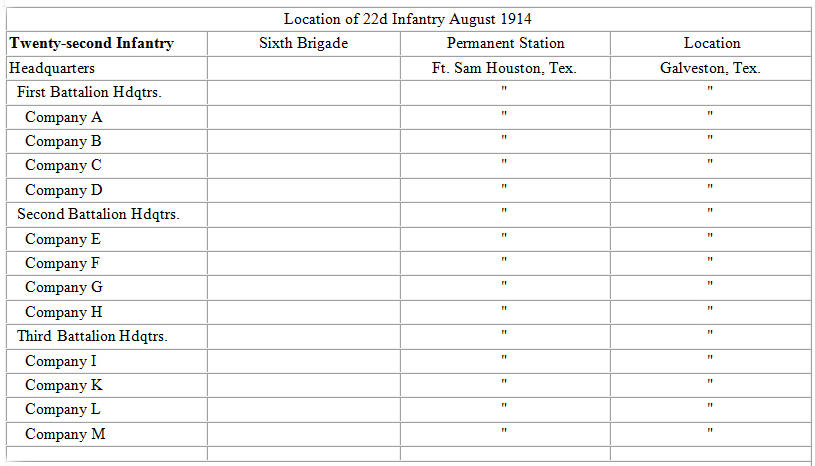
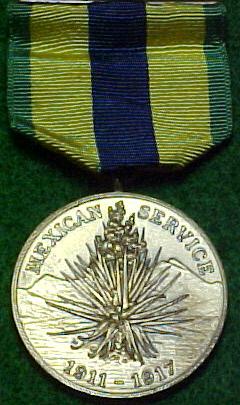
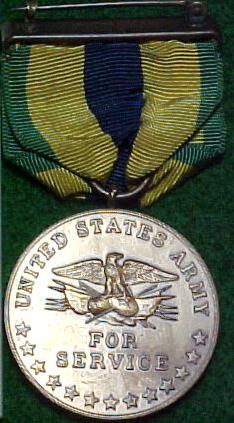
Mexican Service Medal
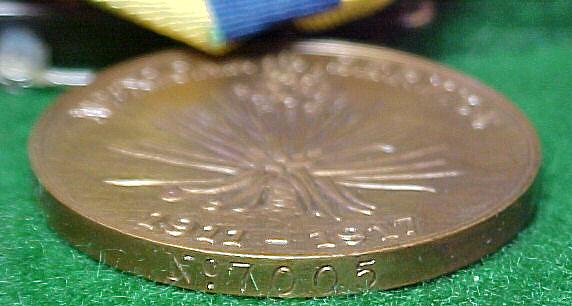
Serial number of above Mexican Service
Medal ( No. 7005)
indicates the medal was awarded to
Sergeant Axel H. Linquist of the U.S. Army for Mexican Service
from 1911-1917.
Linquist was a member of Company H, 22nd Infantry and joined his
Company in
May 1914 as a Private. The medal was presented to Sgt. Linquist
on November 15, 1919.
The long period of division, brigade and
regimental maneuvers was broken in October, 1914,
when the entire regiment was granted a month of comparative rest.
Many leaves of absence were granted to the officers
and most of the enlisted men took advantage of passes. A number
of hunting and fishing parties were organized,
and other forms of recreation and diversion furnished the
officers and men of the regiment with a well-earned holiday.
At 8 P. M., December 15, 1914, orders were
received over the telephone from Division headquarters,
directing the regiment to prepare immediately for service at
Naco, Arizona.
In the vicinity of this town two opposing factions of Mexicans
had intrenched themselves,
and in the course of their operations some stray shots had fallen
in American territory, killing and wounding a number of persons.
The United States government issued a protest and demanded that
the fighting in the vicinity of the international boundary cease
at once.
The demand was to be backed up by the force of troops already at
Naco, augmented by the Sixth Brigade.
The 22nd Infantry was scheduled to start for Naco on! December
16, but lack of railroad transportation delayed the start until 7
A. M. the next day.
The last section of the train carrying the regiment reached Naco
at 10 A. M., December 20.
Shelter tents were pitched north of the town
without delay, but these formed inadequate protection against the
continuous wind and rain storms
which beset the camp for the following week. Large pyramidal
tents were received and erected by the men on the 24th,
bringing much joy and relief to the command. The Third Battalion,
under Major W. T. Wilder, was at once designated for outpost
duty.
The territory in which the battalion undertook this duty was
known as the Naco sector of the line of outposts.
On January 17, 1915, the Mexicans withdrew from their positions
near the border, and the outpost was relieved on the 20th.
On the 25th of January the regiment commenced its move to duty station at Camp Harry Jones, Douglas, Arizona.
During the years 1911-1915 the following soldiers of the Regiment died:
Private Ezra A. Nicholson Company F drowned
while bathing in Salado Creek near the camp of the Maneuver
Division at San Antonio, Texas on May 30, 1911.
Private George P. Carter Company M died at Fort Sam Houston,
Texas of acute tuberculosis contracted in the
line of duty on June 5, 1911.
Cook John L. Ricketts Company E died at Fort Sam Houston, Texas
on July 27, 1911. His death was recorded in
the Returns of the 22nd Infantry as a suicide.
First Sergeant George Shaab Company B died in his quarters at
Fort Sam Houston, Texas on August 28, 1911.
Private Julius Sakaly Company D died in the post hospital at Fort
Sam Houston, Texas on September 24, 1911.
Cause of death was recorded as "Dislocation 5th cervical
vertebra."
Private John Knox Company H died in the post hospital at Fort Sam
Houston, Texas on March 3, 1912.
Private Walter H. Frady Company B was shot and killed at Fort
McPherson, Georgia while trying to escape while
incarcerated for desertion on May 18, 1912.
Private James N. Thompson Company D drowned at Canutillo, Texas
on June 6, 1912.
Private Michael Sheehy Company I died at Fort Sam Houston, Texas
on June 29, 1912.
Corporal Norman J. Oles Company D died at El Paso, Texas on
August 29, 1912.
Private Charles W. Abel Company B died in a hospital at Fort
Bliss, Texas on October 2, 1912.
Private William Johnson Company G died at the Camp at Fort Bliss,
Texas on December 28, 1912.
Cook Bogdan Tokarsky Company K died at Fort Bliss, Texas on
January 2, 1913.
Private Ferdinand F. Plut Company E died at Fort Bliss, Texas on
January 11, 1913. His death was recorded in
the Returns of the 22nd Infantry under the heading of
"Accident."
Artificer Henri Duhamel Company C died at Field Hospital #3 at
Texas City, Texas on April 24, 1913.
Private William Heady Company A died at Galveston, Texas on
September 7, 1913.
Private James Wellington Company C drowned at Texas City, Texas
on October 21, 1913.
Corporal John Dea Company K died at Fort Sam Houston, Texas on
January 13, 1914.
Private Bernardt H. Hillebrand Company D died in March 1914.
Private William Zeh Company A died at Texas City, Texas on April
24, 1914. Cause of death was recorded as
pulminary tuberculosis.
The 1st Battalion website does not have access to the Returns of
the 22nd Infantry for enlisted men from 1915
onward.
**********************
Home | Photos | Battles & History | Current |
Rosters & Reports | Medal of Honor | Killed
in Action |
Personnel Locator | Commanders | Station
List | Campaigns |
Honors | Insignia & Memorabilia | 4-42
Artillery | Taps |
What's New | Editorial | Links |